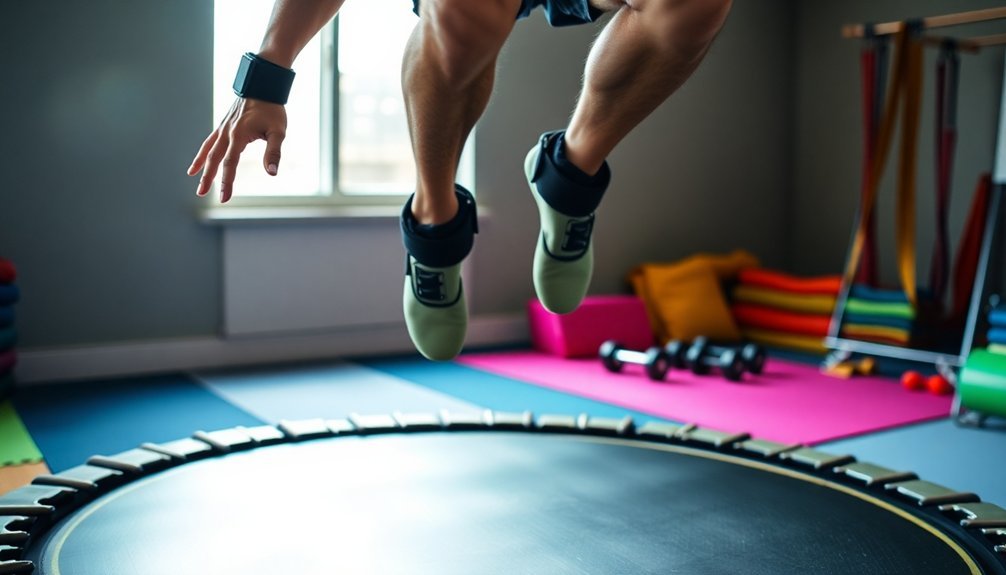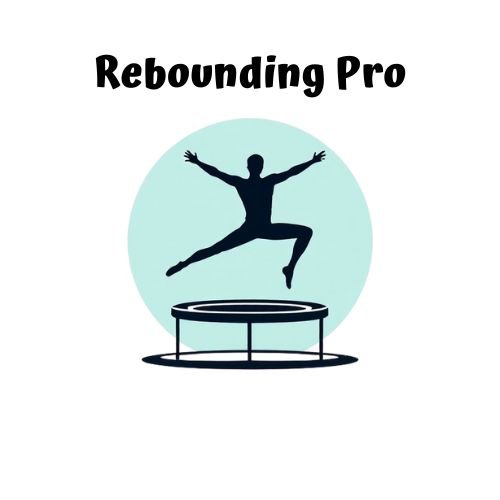Combining weighted jump ropes with rebounding creates an explosive calorie-burning workout that’s 68% more effective than jogging. You’ll torch 13.6 calories per minute while strengthening your shoulders, arms, and core through high-intensity intervals. Try weighted tuck jumps, side-to-side hops, and bounce squats for maximum muscle engagement. Add double-unders and light weights to increase metabolic demand while maintaining proper form. The right technique with these 10 routines will transform your fitness while protecting your joints.
10 Weighted Jump Routines for Maximum Burn

When seeking maximum calorie burn from your jump rope workout, weighted ropes offer a significant advantage over standard options. The heaviest varieties—Muay Thai 2.0 and beaded ropes—can torch an impressive 13.4 to 13.6 calories per minute while intensely engaging your shoulders and arms.
These weighted ropes are perfect for high-intensity interval training (HIIT), where you’ll alternate between vigorous jumping and brief rest periods. A typical 15-20 minute session provides substantial caloric expenditure through both aerobic and anaerobic energy systems. The study demonstrated that weighted ropes create a strong anaerobic challenge compared to lighter alternatives.
For maximum effectiveness, incorporate variety with standard jumps, high knees, single-foot hops, and challenging double unders.
To prevent overtraining, limit HIIT jump rope sessions to once weekly. You’ll boost muscle power and endurance while enhancing fat loss through these strategic, intense workouts.
20-Minute HIIT Rebounding Circuit With Heavy Muay Thai Ropes
This specialized HIIT rebounding circuit takes weighted jump training to new heights by combining a mini-trampoline with heavy Muay Thai ropes for maximum calorie burn.
You’ll torch 20-30% more calories than with steady-state cardio while enjoying the low-impact benefits of rebounding.
Structure your workout with 30-60 second intervals of intense movement followed by equal rest periods. The mindfulness required during these intense intervals improves cognitive function and enhances focus over time. Incorporate tuck jumps, rapid knee lifts, and in-place sprints while manipulating the ropes. Complete 3-5 sets, always maintaining proper form.
Work in powerful bursts, alternating between maximum effort and recovery while mastering both rebounding and rope techniques.
The heavy ropes add resistance that engages your upper body and core, creating a full-body workout that continues burning calories hours after you’ve finished.
Always warm up properly and cool down thoroughly to prevent injury while maximizing the lymphatic and cardiovascular benefits.
Muscle-Engaging Trampoline Intervals Using Weighted Jump Techniques

You’ll maximize muscle engagement by combining weighted jump techniques with strategic trampoline intervals.
Incorporate light dumbbells during bounce exercises like twist jumps and lateral hops to target multiple muscle groups simultaneously.
For an effective HIIT circuit, alternate 30 seconds of weighted movements with 15 seconds of active recovery bounces, keeping your core engaged throughout. Low-impact cardio exercises on mini trampolines provide joint-friendly workouts while still delivering excellent fitness benefits for individuals at all skill levels.
Multi-Muscle Rebound Training
Trampoline workouts transform into powerful full-body conditioning sessions once you add weighted jump techniques to your rebounding routine. By incorporating handheld weights during exercises like squat jumps and lateral bounds, you’ll engage multiple muscle groups simultaneously while maintaining the low-impact benefits that protect your joints.
The key to maximizing results lies in variety and intensity management. Alternate between high-intensity bursts with weighted arm curls and recovery periods with lighter movements. This approach follows the principle of blending strength and hypertrophy training that produces optimal muscle development. Always maintain proper posture and core engagement throughout each exercise.
For beginners, start with a proper warm-up of light bouncing before progressing to more intense weighted intervals.
For safety, verify your mini trampoline is stable before starting, wear appropriate footwear, and gradually increase intensity as your fitness improves.
Weighted Trampoline HIIT Circuit
Maximize your calorie burn with a weighted trampoline HIIT circuit that transforms simple bouncing into an intensive full-body workout.
This high-intensity approach burns calories both during and after your session while engaging multiple muscle groups simultaneously.
Incorporate exercises like weighted tuck jumps, side-to-side hops with dumbbells, and bounce squats to challenge your stability and strength.
Try modified burpees on the trampoline for maximum muscle engagement while protecting your joints from high impact.
Begin with a proper warm-up of light bouncing and arm circles.
Select weights that challenge you without compromising form, and alternate between 30-second intense intervals and 15-second rest periods. The afterburn effect continues calorie burning well after your trampoline HIIT session ends, maximizing the efficiency of your workout.
Always cool down with gentle bounces and stretches to aid recovery.
This adaptable workout suits all fitness levels—simply adjust the weight and intensity to match your capabilities.
Calorie-Torching Tabata Jumps on Mini Trampolines
You’ll maximize your calorie burn with the Springy Intensity Multiplier technique when you combine rapid-fire jumps with brief recovery periods on your mini trampoline.
The Double Bounce Benefits come into play as you’ll engage more muscle groups simultaneously while reducing joint impact compared to floor-based Tabata workouts.
Your metabolism will continue firing long after your session ends, especially when you maintain proper form throughout each 20-second work interval. For optimal results, incorporate varied movements such as twists and high knees to create a full-body workout that increases overall calorie expenditure.
Springy Intensity Multiplier
Two critical components come together in this high-powered workout method: the science-backed Tabata protocol and the dynamic properties of mini trampolines. This combination maximizes your caloric burn while minimizing joint stress.
The trampoline’s elastic surface amplifies your body’s stretch-shortening cycle, enhancing reactive strength and explosive power with each 20-second burst. You’ll burn approximately 15 calories per minute while training both aerobic and anaerobic systems simultaneously.
What makes this approach particularly effective is how the trampoline’s rebound effect intensifies plyometric movements. Your legs develop greater elasticity as you work through the 4-minute cycles. Remember to balance these high-intensity sessions with low intensity days to prevent overtraining and reduce injury risk.
The elevated metabolic rate continues hours after your workout ends, creating an afterburn effect that traditional exercises can’t match.
Always warm up properly and maintain good form to prevent injuries while maximizing results.
Double Bounce Benefits
When paired with the Tabata protocol, double bounce jumps on mini trampolines deliver exceptional fitness results while protecting your joints. This technique absorbs over 80% of impact stress compared to running while engaging your core, glutes, and legs with each rebound.
Following the classic 20-seconds-on, 10-seconds-off Tabata format, you’ll torch calories at a rate comparable to high-intensity running—NASA research shows rebounding is 68% more effective than jogging per effort expended.
Beyond calorie burn, you’ll strengthen your heart, improve bone density, and enhance lymphatic circulation. The rebounding motion actively stimulates lymphatic detoxification, helping your body eliminate waste more efficiently.
The 40-inch workout trampoline provides ample space for these dynamic movements, making this exercise accessible even for beginners.
You’ll enjoy both immediate benefits and long-term metabolic improvements, as regular trampoline workouts boost your resting metabolism for continued calorie burn.
Double-Under Challenges: Taking Weighted Rebounding to New Heights
Double-under challenges represent a significant leap in jump rope intensity, especially when combined with weighted elements for advanced athletes. While not traditionally paired, adding light ankle weights or weighted vests can dramatically increase the metabolic demand and strength benefits.
You’ll need to master proper technique before attempting weighted double-unders, as form breakdown can lead to injury. Focus on maintaining your core stability and consistent rhythm even with the added resistance. Many athletes find that practicing the wrist flick technique in isolation helps achieve the minimum consecutive reps required in progressive double-under challenges.
| Challenge Type | Benefits | Recovery Needs |
|---|---|---|
| Weighted Vest | Upper body endurance | 3:1 work-rest ratio |
| Ankle Weights | Explosive leg power | Joint mobility work |
| Weighted Handle | Grip strength, wrist control | Hand/forearm stretching |
When integrating these challenges, start with short sets (10-15 reps) and gradually build up. Consider supplement support like BCAAs to aid in recovery between these high-intensity sessions.
Full-Body Weighted Bounce Routine for Core Strengthening
Your full-body weighted bounce routine targets deep core muscles while distributing resistance across major muscle groups.
You’ll maximize results by maintaining proper form throughout each bounce, keeping your spine neutral and engaging your abdominals with every landing.
These power-packed exercises strengthen your entire core system, improving both stability and functional strength for everyday activities. The routine engages multiple muscle groups simultaneously, creating an efficient workout that builds definition while supporting your weight loss goals.
Power-Packed Core Exercises
Although many athletes focus primarily on leg strength for jump performance, a powerful core serves as the essential foundation for explosive, weighted bounce routines. Your core transfers force between your lower and upper body, enabling you to achieve greater heights and stability during weighted jumps. A strong core also promotes better posture while executing jump routines, which enhances overall performance and reduces injury risk.
| Exercise | Core Benefit |
|---|---|
| Medicine Ball Slams | Explosive power development through forceful contraction |
| Woodchops | Rotational strength for multi-directional stability |
| Dead Bugs | Anti-extension control critical for jump landings |
| Weighted Planks | Isometric endurance for sustained performance |
| Renegade Rows | Anti-rotation strength while maintaining stability |
Incorporate these movements into your routine 2-3 times weekly, focusing on proper form before adding weight. You’ll notice improvements in jump height and landing stability as your core strength develops, reducing injury risk while maximizing power output.
Weight Distribution Benefits
Properly distributing weights during bounce routines transforms ordinary rebounding into a thorough full-body workout that dramatically enhances core strength.
When you add weights to your rebounding sessions, you’ll engage multiple muscle groups simultaneously, maximizing your exercise efficiency. Your core muscles work overtime to maintain balance while the added resistance activates your legs, glutes, and arms.
This extensive engagement not only strengthens connective tissue but also improves your overall stability and coordination. You’ll notice your posture improving as your core stabilizers develop. Adding weights specifically enhances the already excellent balance improvements that rebounding naturally provides.
For ideal results, gradually increase weight and intensity. This approach prevents injury while allowing you to customize workouts based on your fitness level.
The beauty of weighted rebounding lies in its versatility—you can easily adjust resistance to meet your specific strength goals.
Form Maximizes Results
Three key principles govern effective weighted bounce training: proper posture, controlled movements, and balanced weight distribution. By maintaining proper form throughout your routine, you’ll not only prevent injuries but also guarantee the targeted engagement of your core muscles, including the rectus abdominis and obliques.
When performing weighted jumps, keep your spine neutral and core engaged. This proper technique allows for efficient power transfer while promoting muscle balance. You’ll maximize results by consistently focusing on form over repetition count.
Remember that weighted bounce exercises combine the benefits of dynamic movements with progressive overload, essential for muscle hypertrophy. Many exercises also help strengthen upper body muscles while working the core, creating a comprehensive full-body workout.
As you coordinate these full-body movements, you’re simultaneously improving stability, enhancing cardiovascular health, and building functional strength that translates to better performance in daily activities and sports.
Cross-Training Trampoline Sessions With Varied Rope Weights
Cross-training trampoline sessions with varied rope weights offer a dynamic way to intensify your rebounding workout while developing upper body strength. By integrating weighted ropes with your trampoline routine, you’ll engage multiple muscle groups simultaneously, maximizing calorie burn and efficiency.
Start with basic bouncing while performing arm circles or overhead presses with lighter ropes. As you progress, incorporate plyometric movements like squat jumps or high knees while manipulating heavier ropes for increased resistance. Maintain soft knees and core engaged throughout all jumping movements to protect your joints and maximize stability. You can alternate between fast-paced cardio intervals and strength-focused sets to create a thorough workout.
For best results, combine rope work with plank variations on the trampoline’s unstable surface. This challenges your core stability while the weighted component targets shoulders, biceps, and triceps—transforming a standard rebounding session into a full-body, cross-training powerhouse.
15-Minute Express Burn With Beaded Rope Trampoline Combinations
The Minute Express Burn with beaded rope trampoline combinations delivers maximum impact in minimal time, transforming traditional rebounding into a high-efficiency workout.
Maximize your minutes with this revolutionary rebounding system that transforms bouncing into serious body sculpting.
These high-intensity intervals maximize calorie burn while the trampoline’s forgiving surface protects your joints from impact.
You’ll benefit from the added resistance of beaded ropes, which increases upper body engagement and amplifies cardiovascular benefits.
Circuit training keeps your workout engaging and brisk, allowing you to customize intensity based on your fitness level.
Try alternating 30-second jumping intervals with 15-second rests, incorporating side steps and bounce jumps.
Focus on maintaining a proud chest position throughout each movement to properly engage your core muscles and improve your overall form.
You can modify beaded rope weights as you progress.
Remember to warm up properly and cool down afterward to prevent muscle soreness and promote recovery.
Progressive Intensity Rebounding: From Light to Heavy Rope Transitions
Progressive intensity rebounding takes our workouts to new levels by pairing rebounding exercises with weighted ropes of increasing resistance. This combination maximizes cardiovascular benefits while strengthening muscles through graduated challenges that minimize joint stress. Since rebounding occurs in the vertical plane, it uniquely utilizes gravity’s natural force to enhance the effectiveness of weighted movements.
Begin with a gentle health bounce using lightweight ropes to activate your lymphatic system and warm up your muscles. As you build endurance, shift to heavier ropes for increased resistance while incorporating more dynamic movements.
- Start with 2-minute intervals of light rope work, gradually extending to 5-minute sets as your stamina improves.
- Add jumping jacks and high knees with medium-weight ropes to intensify your cardio burn.
- Finish with 30-second bursts of heavy rope work followed by 60-second recovery periods of gentle bouncing.
Mini Trampoline Technique Mastery Using Weighted Props
Mini trampoline technique mastery elevates your rebounding practice when you incorporate weighted props strategically into your routine. Maintain proper posture with an engaged core and relaxed shoulders while selecting weights appropriate for your strength level. When performing front lunges with weights, ensure your front knee alignment and focus on squeezing your glutes throughout the movement.
For maximum effectiveness, engage your glutes and quads during each jump, and incorporate pulse movements at the end of sets to challenge muscle endurance.
| Technique | Benefit | Safety Tip |
|---|---|---|
| HIIT Intervals | Increased calorie burn | Thorough warm-up required |
| Single-Leg Jumps | Enhanced stability | Start with lighter weights |
| Weighted Lunges | Targeted leg/core work | Inspect equipment regularly |
| Isometric Holds | Deep muscle engagement | Allow adequate recovery time |
Remember to listen to your body signals and stop if you experience pain, as proper recovery between sessions is essential for muscle repair and injury prevention.
Frequently Asked Questions
Are Weighted Jump Routines Safe for Beginners With Joint Issues?
Weighted jumps aren’t ideal if you’ve got joint problems. You’re better off starting with lighter ropes, focusing on proper form, and using modified techniques. Always consult your healthcare provider before beginning any high-impact exercise.
How Often Should I Replace My Weighted Jump Rope?
You should replace your weighted jump rope every 6-12 months with regular use. Inspect it weekly for fraying, loose parts, or handle damage. High-quality ropes last longer, while daily intense use requires more frequent replacement.
Can Pregnant Women Safely Perform Weighted Jump Rope Exercises?
No, you shouldn’t use weighted jump ropes during pregnancy. The high-impact nature and added intensity pose risks to your pelvic floor. Consult your healthcare provider for safer pregnancy exercise alternatives instead.
What Shoes Are Best for Weighted Jump Rope Workouts?
For weighted jump rope workouts, you’ll want shoes with firm ankle support, minimal tread, good cushioning, and low heel drop. Cross trainers, basketball shoes, or minimalist footwear with wide toe boxes work best for stability and performance.
Do Weighted Jump Routines Help With Bone Density Improvement?
Yes, weighted jump routines greatly boost your bone density. They apply greater mechanical stress to your bones than unweighted jumps, stimulating more bone growth, particularly in your hips and femoral neck areas.
In Summary
You’ve now got 10 powerful ways to supercharge your rebounding workouts with weighted elements. By incorporating these jumping routines into your fitness regimen, you’ll maximize calorie burn while building strength and endurance. Don’t be afraid to challenge yourself with heavier ropes or more intense intervals. Your body will respond quickly to these dynamic combinations, delivering results that standard cardio simply can’t match. Ready, set, jump!





Leave a Reply